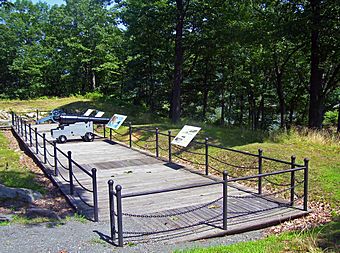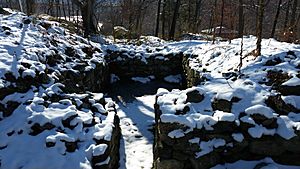Fort Montgomery (Hudson River) facts for kids
|
Fort Montgomery State Historic Site
|
|

Cannons at the site of the fort, 2007
|
|
| Location | Fort Montgomery, Highlands, New York, USA |
|---|---|
| Nearest city | Peekskill |
| Built | 1776 |
| NRHP reference No. | 72000897 |
Quick facts for kids Significant dates |
|
| Added to NRHP | November 28, 1972 |
| Designated NHL | November 28, 1972 |
Fort Montgomery was an important fort built by American soldiers during the American Revolution. It was located on the west side of the Hudson River in Highlands, New York. This fort was built in 1776. It was one of the first big projects the Americans made to protect their land.
Today, Fort Montgomery is a special place called a National Historic Landmark. It is part of the Hudson River Valley National Heritage Area. The state of New York takes care of it as the Fort Montgomery State Historic Site. Visitors can explore the ruins and learn about its history.
Contents
Why the Hudson River Was Important
The Hudson River was very important during the American Revolution. Both the Americans and the British knew this. The river was like a highway for moving supplies and soldiers. It connected many parts of the northeast.
The spot where Fort Montgomery was built was special. People had known since the 1600s that this location was perfect. It was a great place to control who could travel up and down the river.
Planning the Forts
After the first fight at Lexington, American leaders decided to build forts. On May 25, 1775, they agreed to build forts in the Hudson Highlands. The goal was to stop the British from taking control of the river. If the British controlled the Hudson, they could split the American colonies in half.
The leaders wanted to build "batteries" (places for cannons) on both sides of the river. This would stop any British ships from bothering people living along the river.
Building Fort Montgomery
James Clinton and Christopher Tappan, who lived nearby, helped find the best spots. At first, they picked an island further north. It was called Martlaer's Island, across from West Point. Plans for this first fort included four strong corners called bastions.
Construction started in the summer of 1775. By November, it had 70 cannons. But building this fort was difficult and expensive. So, the Americans decided to stop that project.
A New Location
A new location was suggested in January 1776. This new spot was on the north side of Popolopen Creek. It was across from a place called Anthony's Nose. All the building materials from the first fort were moved here.
Construction on the new Fort Montgomery began in March 1776. This new location was much better.
Fort Montgomery's Features
Fort Montgomery was built where Popolopen Creek meets the Hudson River. This was near Bear Mountain in Orange County, New York. The fort had several important parts:
- A river battery with six large 32-pound cannons.
- A huge chain and boom stretched across the Hudson River. This was to stop enemy ships.
- Strong walls and small forts called redoubts on the land side. These were connected by ramparts.
- The whole fort was on a cliff, about 100 feet (30 meters) above the river.
General George Clinton, who was also the new governor of New York, was in charge of the fort.
Fort Clinton and the River Chain
Fort Montgomery had a smaller partner fort called Fort Clinton. It was on the south bank of Popolopen Creek. Together, these two forts had about 700 American soldiers. These soldiers came from different groups, including the 5th NY Regiment and local militias.
The land across Popolopen Creek was important too. It was a high cliff that looked down on Fort Montgomery. So, it had to be protected. These two forts and their cannons controlled this part of the Hudson River.
The Army also planned a huge engineering project. They wanted to block any British ships from sailing north. In 1776, they built a giant chain and boom across the river. This was a physical barrier. It worked with the cannons from the forts to stop ships.
In July 1776, a New York committee worked to get more cannons. They wanted to make sure the river was well protected.
The Battle of Fort Montgomery
On October 6, 1777, a large British force attacked Fort Montgomery. This force had about 2,100 soldiers. They were a mix of Loyalists (Americans who supported the British), Hessians (German soldiers fighting for the British), and British regulars.
Lieutenant General Sir Henry Clinton led this attack. They attacked the forts from the land side. The defenses there were not fully finished. British ships on the Hudson River also fired their cannons. These ships had managed to get past some barriers in the lower river.
By the end of that day, both Fort Montgomery and Fort Clinton had fallen to the British. The British then burned the forts. They also tore down the stone buildings.
Why the Battle Mattered
Even though the British won the battle, it didn't help them much in the long run. Their attack on the forts caused delays. These delays meant they couldn't send help to General John Burgoyne at Saratoga.
Just ten days later, the Americans won a big victory at the Battle of Bemis Heights. This forced Burgoyne to surrender at the Battle of Saratoga. The British help he needed was still far to the south. So, the battle at Fort Montgomery, while a loss for the Americans, helped them win the larger war.
Visiting the Historic Site
Fort Montgomery was named a National Historic Landmark in 1972. Today, visitors can walk along trails. Signs explain the history of the fort's ruins.
A special Visitor Center opened in October 2006. It was designed by architect Salvatore Cuciti. The building is about 5,700 square feet (530 square meters). It is built to give visitors a great view down the Hudson River.
The Visitor Center is a state museum. It has many items found at the fort. There are also models of soldiers and a detailed model of the fort. It helps visitors imagine what the fort was like long ago.
See also




